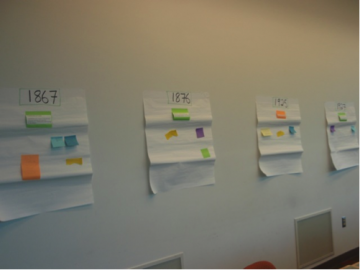Objectives
- To develop a personal connection with the local histories at UBC against the backdrop of broader historical contexts.
- To address multiple ways in which people with different backgrounds are related to histories of this place.
Note to facilitator
- You can facilitate the activity in two ways – either in Variation 1 or 2. Variation 2 requires you more preparation time than Variation 1, but it gives you more flexibility and control over the content that you would like participants to explore.
Homework
- Participants investigate and list key events from their family history (e.g., when their family immigrated to Canada, significant events for their family members, political events that impacted their family).
- Participants review the timeline and select 2-4 events that correspond to their family history or that speak to them.
- Participants reflect on the learning process. Some reflection questions to consider:
- What surprised you? (e.g., things you didn’t know or expect)
- How is your history related to the history of this place?
- Do you see your relationship with this place differently before and after going through the timeline? How? Why?
- What did you find challenging and/or interesting when you related your history to the histories presented on the timeline? Why?
Variation 1: Pair and share our family histories
- Participants get paired up and discuss based on the homework (Note: They share only what they are willing to share):
- The events they selected from the timeline and how the selected events are related to them.
- Their learning reflections.
- Differences and similarities between the partners’ family histories and reflections.
- Participants discuss in a large group and (or reflect individually) what they have learned from the exercise. Some discussion/reflection questions to consider:
- What did you learn from sharing your history and reflections with your partner?
- What do the differences and similarities between people’s histories tell us about our social relations in this current time and place?
- How did you feel in the sharing process? Why?
- What would you like to learn more about?
Variation 2: Histories on the wall
Preparation
- Select 5-10 events that you would like to highlight from the Canada/BC row of the timeline and write the years and events on flipchart sheets (one event per sheet).
- Select 5-10 events from UBC and UBC Aboriginal Engagement rows of the timeline and write each event on a large sticky note (one event per sticky note).
- You may select UBC and UBC Aboriginal Engagement events that match (approximately or exactly) the years that you selected from the Canada/BC row.
- (Optional) On large sticky notes, write key events in your teaching subject that you would like to address (one event per sticky).
- Examples: The years when important policies passed, key historical events in another country, key historical events for a particular group of people, important disciplinary figures’ (e.g., writers, politicians, composers) life events.
- Alternatively, you can make this research/selection process an assignment for participants.
- Put up the flipchart sheets (from #1) on the wall in a chronological order. Place enough space between sheets.
Activity
- Facilitator walks around the room and explains the key Canada/BC events that are placed on the wall one by one. To demonstrate multiple layers of Canadian history, as going through the Canada/BC events, the facilitator places the sticky notes about UBC/UBC Aboriginal Engagement events (from Preparation #2 above) and optionally subject events (from Preparation #3 above).
- Participants jot down their thoughts on sticky notes (an item per sticky note). Some reflection questions to consider:
- What stood out to you?
- What is your relationship with the year/event?
- What is missing?
- Participants place their sticky notes (only those that they are willing to share with others) on the wall. (See Image below.)
- Participants walk around the room to review the posted comments on the wall.
- Participants stand in front of the year/event and tell a story: “This year/event is significant to me because…”
- Participants discuss in a large group and/or reflect individually what they have learned from the exercise. Some discussion/reflection questions to consider:
- What stood out to you in this exercise?
- What do the differences and similarities between people’s histories tell us about our social relations in this current time and place?
- What would you like to learn more about?
